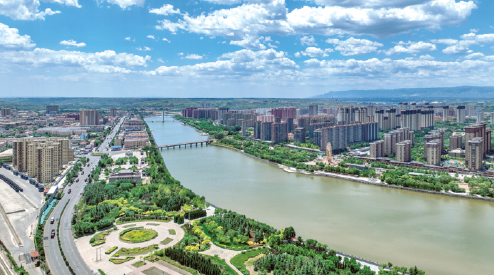River chiefs keeping watch over liquid assets
Updated: 2023-08-18

The Fenhe River in Xiangfen county has a visibly better environment and ecosystem compared with previous years. [Photo by Yan Ruipeng for China Daily]
Officials designated across all bodies of water in Shanxi help improve environment and local economy
With a river chief system in place across the province of Shanxi, even a small river like Wenhe has dedicated officials to taking care of it.
Wenhe, a river of about 80 kilometers in length through the city of Yangquan, is now under the custody of dozens of officials at the village, township, county and city levels.
Gao Haizhu, secretary of Podi village subcommittee of the Communist Party of China and head of the local villagers' committee, is one such river chief.
Inspecting the village's section of the river is now part of his daily routine. Gao usually gets up early in the morning and walks along the river to see if any trash has been dumped or sewage illegally discharged.
"Random littering was commonplace along the river in the past, which had made the Wenhe an unpleasant place," Gao said. "But now the environment is changing for the better after officials like me were appointed river chiefs (in 2018)."
He said the river chiefs' tasks are ensuring the river's environment is protected and helping to improve the local residents' awareness of environmental protection.
Gao said he is happy to see the river becoming cleaner. And the improving environment has brought benefits to residents with a more prosperous rural tourism industry.
Podi is close to Niangziguan, a major tourist attraction in Yangquan. The locale is known as a significant pass on China's Great Wall.
"Many families in Podi are engaged in tourism-related operations like bed-and-breakfast accommodations and the retail of specialty produce and souvenirs," Gao said. "The improved environment, the scenic river valley and mountains and our proximity to the Niangziguan Pass, make Podi an increasingly appealing destination for tourists."
Shanxi began to implement a river chief system in 2017. A river chief is usually the chief of the local CPC committee and head of the local government, responsible for a section of the river. The system is also applicable for lakes and other water bodies throughout the province.
Shanxi's water bodies are now taken care of by more than 16,500 river and lake chiefs at the village, township, county, city and provincial levels.
In recent years, governments in Shanxi have renewed their efforts to enhance and improve the river chief system.
The force for watercourse monitoring and protection has now been strengthened with the recent addition of such posts of assistants to river or lake chiefs and river or lake inspectors.
It is worth mentioning that law enforcement officials, like police officers and prosecutors, have been added to the watercourse monitoring force, laying a solid basis for watercourse protection in the framework of rule of law.
Du Xiaoyun, chief of the water resources bureau in the central Shanxi city of Jiexiu, said he saw substantially improved efficiency when police officers and prosecutors were added to the watercourse protection team.
He cited the removal of an illegally built facility on the flood passage of the Ciyao River in Jiexiu.
"The facility, constructed by a local company, had been there for several years, despite our repeated persuasion," Du said. "It had posed a severe threat to the river during floods."
With the intervention of the prosecutors, the problem was solved immediately. The company demolished the illegal facility and returned the land to the river in May 2022.
"We told the company's executives it could be a subject of public interest litigation according to related laws," said Zhao Taotao, a Jiexiu prosecutor.
He said the company responded quickly because its executives realized it could be a serious problem from a legal point of view.
It is reported that nearly 2,700 police officers and prosecutors throughout Shanxi have joined the watercourse protection missions.
Shanxi is also encouraging the engagement of public volunteers in the monitoring and protection of rivers and lakes.
Wang Jin, 50, is a resident in Yangquan. She joined a 51-strong volunteers' team for monitoring and protecting the Taohe, another river in the city, in May 2022.
Wang said it was the first volunteering team for river inspection in Shanxi province. Consisting of civil servants, residents and retirees, the team's members fulfill their river-monitoring missions in their spare time and on an irregular basis.
"Our tasks include reporting the discharge of untreated sewage and other pollutants, picking up garbage on the riverbed and holding events to lift residents' awareness and enthusiasm in river protection.
"It's quite often that we take our children to these actions. These are good opportunities for them to learn from good social practices and norms," Wang said.
Shanxi is also promoting the use of digital technologies in the protection of rivers and lakes.
In Qixian county, which is a part of the central Shanxi city of Jinzhong, river inspector Hao Jinzhen was doing his daily inspection work along the Wuma River.
"If I find any area of illegal dumping and pollutant discharge, I would take pictures and report to the authorities through a smartphone app called 'Jinzhong smart water resources'," Hao said. "The app allows a swift response from the authorities."
The findings of inspectors like Hao are transmitted to the control room of the Jinzhong water resources bureau in real time. A huge screen in the room displays the data and images from 111 major rivers and 63 reservoirs and lakes in the city.
"In addition to reports from inspectors, we have a monitoring network of field cameras, drones and even satellites," said Liu Jian, an official at the bureau.
"In addition to monitoring the ecological environment of rivers and lakes, the network is a comprehensive system that highlights flood control and rationalizing water use among various areas based on the collected data of water resource distribution," Liu added.
Kang Meixiang and Fan Zhen contributed to this story.



